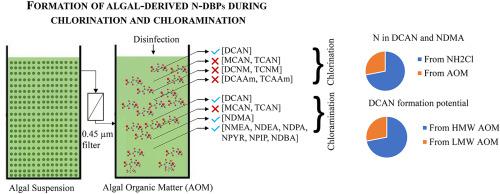Water Research ( IF 11.4 ) Pub Date : 2020-06-16 , DOI: 10.1016/j.watres.2020.116047 X Li 1 , N R H Rao 1 , K L Linge 2 , C A Joll 3 , S Khan 4 , R K Henderson 1

|
Algal cells and algal organic matter (AOM) are a source of high dissolved organic carbon (DOC) and nitrogen (DON) concentrations. This poses a possible health risk due to their potential to form disinfection by-products (DBPs), some of which may be of health concern, after disinfection. While several studies have focussed on the formation of carbonaceous DBPs from AOM, only a few studies have focussed on the formation of nitrogen containing N-DBPs from AOM. Hence, the main aim of this study was to thoroughly investigate the N-DBP formation potential of the AOM from a species of cyanobacteria commonly found in natural waters, Microcystis aeruginosa. Three haloacetonitriles, two halonitromethanes, two haloacetamides, and eight N-nitrosamines were analysed by gas chromatography-mass spectrometry after chlorination and chloramination of the extracted AOM. To provide further insight into the influence of changing DON character on N-DBP formation potential, the AOM from three other species, Chlorella vulgaris, Dolichospermum circinale and Cylindrospermopsis raciborskii, were also tested. Dichloroacetonitrile (DCAN) was the DBP formed in the highest concentrations for both chlorination and chloramination of bulk AOM from all the species. Furthermore, during chlorination and chloramination, the high molecular weight fraction (>1 kDa) of AOM from M. aeruginosa had a greater DCAN formation potential (normalised to DOC or DON) than the AOM in the low molecular weight fraction (<1 kDa) of M. aeruginosa, regardless of growth stage. N-Nitrosamine formation from the bulk AOM of all species occurred only after chloramination. The molar concentration of N-nitrosodimethylamine (NDMA) was lower than the other N-nitrosamines detected. However, NDMA formation increased with culture age for all four species, in contrast to most other N-nitrosamines whose formation remained consistent or decreased with culture age. Overall, algal growth could result in elevated concentrations of N-DBPs due to the increasing concentrations of high molecular weight algal DON in the AOM. It is suggested that the AOM comprises precursors containing long C-chain amine (R1-NH-R2) or cyclic N-containing amine structures. Comparisons to previously measured N-DBP concentrations in drinking water suggest that the AOM from the algae and cyanobacteria examined in this study are not likely to be a major source of precursors for either DCAN or NDMA in real waters. However, AOM may present a major precursor source for other N-nitrosamines.
中文翻译:

在氯化和氯化过程中形成源自藻类的含氮消毒副产物。
藻类细胞和藻类有机物(AOM)是高溶解有机碳(DOC)和氮(DON)浓度的来源。由于其在消毒后可能形成消毒副产物(DBP),其中一些可能与健康有关,因此可能造成健康风险。虽然一些研究集中于由AOM形成碳质DBP,但只有少数研究集中于由AOM形成含氮N-DBP。因此,本研究的主要目的是彻底研究天然水域铜绿微囊藻中常见的一种蓝细菌对AOM的N-DBP形成潜力。三个卤代乙腈,两个卤代硝基甲烷,两个卤代乙酰胺和八个N萃取的AOM进行氯化和氯化后,通过气相色谱-质谱法分析亚硝胺。为了进一步了解DON特性的变化对N-DBP形成潜能的影响,还测试了来自其他三个物种的小球藻,圆环小孢子和圆环青冈的AOM 。二氯乙腈(DCAN)是用于所有物种的大宗AOM的氯化和氯化的最高浓度的DBP。此外,在氯化和氯化过程中,铜绿假单胞菌的AOM的高分子量级分(> 1 kDa)比低分子量级分(<1 kDa)的AOM具有更大的DCAN形成潜力(标准化为DOC或DON)。的铜绿假单胞菌,无论其生长期如何。所有物种的大块AOM均会形成N-亚硝胺,仅在氯化后才发生。N-亚硝基二甲胺(NDMA)的摩尔浓度低于检测到的其他N-亚硝胺。然而,与所有其他四个N-亚硝胺的形成保持一致或随培养年龄下降的大多数其他N-亚硝胺相反,NDMA的形成随着培养年龄的增加而增加。总体而言,由于AOM中高分子量藻类DON的浓度增加,藻类的生长可能导致N-DBPs浓度升高。建议AOM包含含有长C链胺(R 1 -NH-R2)或环状含氮胺结构。与先前测量的饮用水中N-DBP浓度的比较表明,在这项研究中检查的藻类和蓝细菌的AOM不太可能是真实水中DCAN或NDMA的前体的主要来源。但是,AOM可能是其他N-亚硝胺的主要前体来源。











































 京公网安备 11010802027423号
京公网安备 11010802027423号